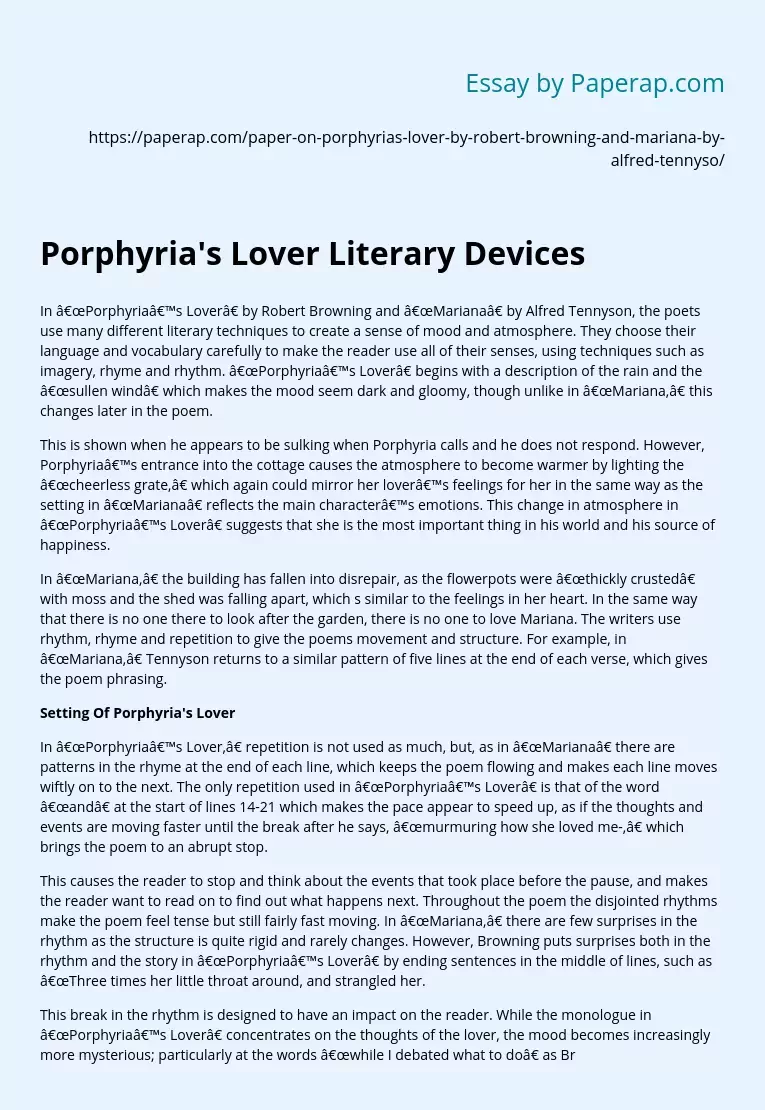In “Porphyria’s Lover” by Robert Browning and “Mariana” by Alfred Tennyson, the poets use many different literary techniques to create a sense of mood and atmosphere. They choose their language and vocabulary carefully to make the reader use all of their senses, using techniques such as imagery, rhyme and rhythm. “Porphyria’s Lover” begins with a description of the rain and the “sullen wind” which makes the mood seem dark and gloomy, though unlike in “Mariana,” this changes later in the poem.
This is shown when he appears to be sulking when Porphyria calls and he does not respond. However, Porphyria’s entrance into the cottage causes the atmosphere to become warmer by lighting the “cheerless grate,” which again could mirror her lover’s feelings for her in the same way as the setting in “Mariana” reflects the main character’s emotions. This change in atmosphere in “Porphyria’s Lover” suggests that she is the most important thing in his world and his source of happiness.
In “Mariana,” the building has fallen into disrepair, as the flowerpots were “thickly crusted” with moss and the shed was falling apart, which s similar to the feelings in her heart. In the same way that there is no one there to look after the garden, there is no one to love Mariana. The writers use rhythm, rhyme and repetition to give the poems movement and structure. For example, in “Mariana,” Tennyson returns to a similar pattern of five lines at the end of each verse, which gives the poem phrasing.
Setting Of Porphyria’s Lover
In “Porphyria’s Lover,” repetition is not used as much, but, as in “Mariana” there are patterns in the rhyme at the end of each line, which keeps the poem flowing and makes each line moves wiftly on to the next. The only repetition used in “Porphyria’s Lover” is that of the word “and” at the start of lines 14-21 which makes the pace appear to speed up, as if the thoughts and events are moving faster until the break after he says, “murmuring how she loved me-,” which brings the poem to an abrupt stop.
This causes the reader to stop and think about the events that took place before the pause, and makes the reader want to read on to find out what happens next. Throughout the poem the disjointed rhythms make the poem feel tense but still fairly fast moving. In “Mariana,” there are few surprises in the rhythm as the structure is quite rigid and rarely changes. However, Browning puts surprises both in the rhythm and the story in “Porphyria’s Lover” by ending sentences in the middle of lines, such as “Three times her little throat around, and strangled her.
This break in the rhythm is designed to have an impact on the reader. While the monologue in “Porphyria’s Lover” concentrates on the thoughts of the lover, the mood becomes increasingly more mysterious; particularly at the words “while I debated what to do” as Browning has lready told us that the love of Porphyria is “all in vain” though we do not know why. Those words suggest to us already that something may happen, as the lover knows that he can never keep Porphyria forever.
However, this is followed by “That moment she was mine, mine, fair,” and this could be what causes him to kill Porphyria as he wants to keep her in this way forever. A similar mysterious atmosphere is used throughout “Mariana,” and the reader feels throughout the poem that something bad is going to happen. The story of the poem is simply Mariana plunging deeper and eeper into depression, so the mysterious atmosphere progresses into one of sadness as the poem goes on.
As Porphyria is murdered, very little punctuation is used so the reader can almost imagine Porphyria’s hair being “wound three times her little throat around” gently and softly. The flowing rhythm makes the mood eerily calm, and this feeling continues right to the end of the poem. The opposite effect is created in “Mariana,” as Tennyson uses punctuation such as commas and semi-colons to create breaks, which gives the poem a slow pulse and almost shows the passage of time hat Mariana has to put up with.
The last three to four lines of each poem have many similarities. Both refer to God, showing the religious thoughts of the time, and, more importantly, the both leave the reader wondering what happens next, and leave many questions unanswered. “Porphyria’s Lover” and “Mariana” are both examples of how poets can create depressing and eerie moods and atmosphere using clever vocabulary, imagery, rhyme and rhythm. I think that the poems are both quite romantic, but are both examples of how too much love can be a bad thing.
Porphyria's Lover Literary Devices. (2019, Dec 05). Retrieved from https://paperap.com/paper-on-porphyrias-lover-by-robert-browning-and-mariana-by-alfred-tennyso/

